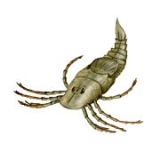
Hibbertopterus
Encyclopedia
Hibbertopterus is a genus of giant sea scorpion
(order Eurypterida) that inhabited the swamps of Scotland
during the Carboniferous
.
Hibbertopterus is a member of the family Hibbertopteridae, large bizarre Eurypterid
s found from the Upper Devonian
to the end of the Permian
period. They were sweep feeders, inhabiting freshwater swamps and rivers, feeding by raking through the soft sediment with blades on their anterior appendages to capture small invertebrates. Their morphology was so unusual that they have been thought to be an order separate to Eurypterida. Recent work however confirms them to be a derived member of the suborder Stylonurina, with the genus
Drepanopterus
being a basal member of their superfamily
.

have been found in West Lothian
, Scotland . The track found was roughly six metres long and a metre wide, and suggests that the eurypterid
was 1.6 metres in length.
The specimen itself is the base of overlying and infilling sandstone
and thus shows the tracks in negative relief: a groove appears as a ridge.
Sea Scorpion
Sea Scorpion may refer to:* Eurypterids, members of the extinct class Eurypterida* some members of the Cottidae family of fish including the Long-spined Sea Scorpion and Short-spined Sea Scorpion...
(order Eurypterida) that inhabited the swamps of Scotland
Scotland
Scotland is a country that is part of the United Kingdom. Occupying the northern third of the island of Great Britain, it shares a border with England to the south and is bounded by the North Sea to the east, the Atlantic Ocean to the north and west, and the North Channel and Irish Sea to the...
during the Carboniferous
Carboniferous
The Carboniferous is a geologic period and system that extends from the end of the Devonian Period, about 359.2 ± 2.5 Mya , to the beginning of the Permian Period, about 299.0 ± 0.8 Mya . The name is derived from the Latin word for coal, carbo. Carboniferous means "coal-bearing"...
.
Hibbertopterus is a member of the family Hibbertopteridae, large bizarre Eurypterid
Eurypterid
Eurypterids are an extinct group of arthropods related to arachnids which include the largest known arthropods that ever lived. They are members of the extinct order Eurypterida ; which is the most diverse Paleozoic chelicerate order in terms of species...
s found from the Upper Devonian
Devonian
The Devonian is a geologic period and system of the Paleozoic Era spanning from the end of the Silurian Period, about 416.0 ± 2.8 Mya , to the beginning of the Carboniferous Period, about 359.2 ± 2.5 Mya...
to the end of the Permian
Permian
The PermianThe term "Permian" was introduced into geology in 1841 by Sir Sir R. I. Murchison, president of the Geological Society of London, who identified typical strata in extensive Russian explorations undertaken with Edouard de Verneuil; Murchison asserted in 1841 that he named his "Permian...
period. They were sweep feeders, inhabiting freshwater swamps and rivers, feeding by raking through the soft sediment with blades on their anterior appendages to capture small invertebrates. Their morphology was so unusual that they have been thought to be an order separate to Eurypterida. Recent work however confirms them to be a derived member of the suborder Stylonurina, with the genus
Genus
In biology, a genus is a low-level taxonomic rank used in the biological classification of living and fossil organisms, which is an example of definition by genus and differentia...
Drepanopterus
Drepanopterus
Drepanopterus is an extinct genus of eurypterid. There are currently two species assigned to the genus. The genus has in the past been assigned its own family, with nine species associated with the genus Drepanopterus, however five of these have since been proven to be synonyms of pre-existing...
being a basal member of their superfamily
Taxonomic rank
In biological classification, rank is the level in a taxonomic hierarchy. Examples of taxonomic ranks are species, genus, family, and class. Each rank subsumes under it a number of less general categories...
.

Trackway
Hibbertopterus is believed to have been one of the first aquatic animals to exhibit terrestrial locomotion, as tracks indicating a dragging movementFossil trackway
A fossil trackway is a type of trace fossil, a trackway made by an organism. Many fossil trackways were made by dinosaurs, early tetrapods, and other quadrupeds and bipeds on land...
have been found in West Lothian
West Lothian
West Lothian is one of the 32 unitary council areas in Scotland, and a Lieutenancy area. It borders the City of Edinburgh, Falkirk, North Lanarkshire, the Scottish Borders and South Lanarkshire....
, Scotland . The track found was roughly six metres long and a metre wide, and suggests that the eurypterid
Eurypterid
Eurypterids are an extinct group of arthropods related to arachnids which include the largest known arthropods that ever lived. They are members of the extinct order Eurypterida ; which is the most diverse Paleozoic chelicerate order in terms of species...
was 1.6 metres in length.
The specimen itself is the base of overlying and infilling sandstone
Sandstone
Sandstone is a sedimentary rock composed mainly of sand-sized minerals or rock grains.Most sandstone is composed of quartz and/or feldspar because these are the most common minerals in the Earth's crust. Like sand, sandstone may be any colour, but the most common colours are tan, brown, yellow,...
and thus shows the tracks in negative relief: a groove appears as a ridge.
Species
- Hibbertopterus Kjellesvig-Waering, 1959
- ?Hibbertopterus hibernicus (Baily, 1872) — Carboniferous, Ireland
- Hibbertopterus permianus Ponomarenko, 1985 — Permian, Russia
- Hibbertopterus scouleri (Hibbert, 1836) — Carboniferous, Scotland

